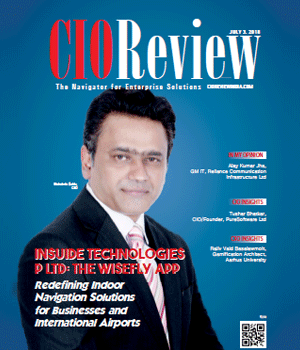
Application Management System
Ashwin Prajapati, CIO, Symphony Limited | Thursday, 26 July 2018, 07:18 IST
 Managing life cycle of one application is a challenge but how do you go about the application lifecycle management process when you are left out in the jungle of applications and integration strategy is a key for getting desired output in stipulated time frame by the management team.
Managing life cycle of one application is a challenge but how do you go about the application lifecycle management process when you are left out in the jungle of applications and integration strategy is a key for getting desired output in stipulated time frame by the management team.
Organizations use a number of software applications like Supply Chain Management (SCM), Enterprise Resource Planning (ERP), and Customer Relationship Management (CRM) for different business processes. These disparate software applications have to be properly integrated if they are to be effective and provide a holistic view of an organization’s systems. Organizations must develop the ability to quickly assimilate and analyze any information and convert it to profitable use to succeed in today’s highly competitive business environment.
"Application maintenance is a critical, yet unheralded, activity in most IT organizations. Left unmanaged, maintenance costs can easily spiral out of control to consume the lion’s share of the IT budget"
The integration strategy is a key and centre stage for CIO, and need to have Enterprise application integration solutions successfully, organizations have to capture business processes in a logical way and align them with their business objectives. Moreover, while considering vendors’ products, organizations should choose the product that meets their business objectives.
Today in the era of MBO (management by objective) application management is a backbone for any organization irrespective of size - large, medium or small, and systems can be used by businesses strategically to achieve a competitive advantage by selecting and deploying right applications with set right expectations for stakeholders. This will help CIO and IT team with better management and achieve desired results.
Application maintenance is a critical, yet unheralded, activity in most IT organizations. Left unmanaged, maintenance costs can easily spiral out of control to consume the lion’s share of the IT budget. As the saying goes, “If you don’t manage maintenance, it will manage you.” Hence, to explore the organizational issues of application maintenance, application management is very important for business & IT.
The increased use of information technology brings the difficulty of managing support and maintenance for enterprise applications. Since this forms a major part of the IT annual spend, IT management normally looks into any opportunity to potentially optimize the spend in this area without impacting the service delivery. Here IT will have to constantly hunt for OpEx model vs CapEx for managing apps.
Ongoing support, maintenance, and enhancement of applications are challenges that every organization faces as its business requirements evolve. At the same time, they also present a strong potential for cost savings in global enterprises. Managed services for comprehensive maintenance and support services enable clients to economically manage complex application portfolios. Some of the benefits of outsourcing application maintenance and support are: Lower recurring cost of maintaining existing applications Improved quality and consistent services levels Lower risk of downtime Greater end-user satisfaction. Hence, SAS & PAS models are very popular and organization will have to align business process rather than developing own applications and constantly spend on improvement.

Over a period of usage, the application may run out of performance due to unexpected problems. Based on user experience there could be suggestions for changes in the functionalities or mode of operation. Also for enterprise applications, there may be requirement of emergency updates due to unexpected business requirements. To avoid these bottlenecks in the applications, continuous maintenance of the application should be properly insured. This is achieved by a partner with the right size of company for application support and hosting solution where the partner will take care of agreed performance.
An article recently published by Forrester "The Emerging Third- Party Software Support Marketplace: Questions and Answers" gives credibility to 3rd party support industry and outlines reasons CIOs are moving away from vendor application support. Ever shrinking IT budgets combined with plans for new IT projects are causing many IT executives to look to reducing software support costs. In a poll conducted by Forrester respondents reported the reasons they are considering third-party support:
Measuring application performance
Two sets of performance metrics are closely monitored. The first set of performance metrics defines the performance experienced by end users of the application. One example of performance is average response times under peak load.
The second set of performance metrics measures the computational resources used by the application for the load, indicating whether there is adequate capacity to support the load, as well as possible locations of a performance bottleneck. Measurement of these quantities establishes an empirical performance baseline for the application.
CIO Viewpoint
UX- The broad picture from 'what was' to 'what...
By Kamal Sharma, CIO, Tally Solutions Pvt. Ltd.
IoT - Initiating the Next Industrial Revolution
By Vipin Kumar, Group CIO, Escorts
Creating a Tangible Impact through Collaboration
By Matt Schlabig, CIO, Worthington Industries
CXO Insights
When the Internet of Things meets Analytics
By Salil Godika, Chief Strategy & Marketing Officer, Happiest Minds Technologies
Cyber Risks: Balancing Innovation and Resilience
By Aditya Samag, VP-Cyber Risk, Marsh India Insurance Brokers
Perfect Plant Initiative Embraced with Industry...







